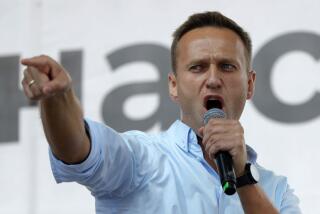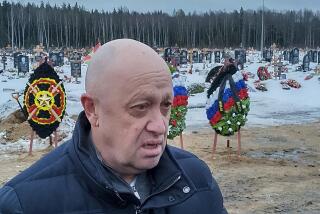TV Shines Klieg Lights on Cast From Kremlin : Soviet Union: Leaders face citizens’ tough questions. The goal is to force aloof figures to be responsive.
- Share via
MOSCOW — “Politburo: The TV Show” made its debut on state-run television Monday night with a high-powered cast and almost everything else a civic-minded Soviet viewer could want.
It had Phil Donahue-like suspense as the Communist Party’s new No. 2 official, put under the klieg lights before a nationwide audience, was asked point-blank whether he is a relative of President Mikhail S. Gorbachev’s wife, Raisa. (He said he isn’t.)
There was emotion, as the highest-ranking woman in the Communist Party expressed compassion for mothers whose sons have been sent to the Caucasus region to quell ethnic violence there.
Even a hint of soap opera-type scandal intruded, as the Kremlin high and mighty talked about whether they and their children get special privileges not available to the masses. (They said they don’t.)
For the Communist Party, which has taken its share of hits from the new openness in mass media, the premiere of what was officially called “Political Dialogue: Who’s Who” was a 90-minute televised opportunity to show citizens from Siberia to Smolensk that the new breed of party official does care.
Four members of the Politburo and Secretariat elected at this month’s party congress sat behind a horseshoe-shaped table to answer questions from viewers relayed by moderator Igor S. Fesunenko, and they seized the occasion to do some image shaping.
“We’ve all come up though the work collectives; we understand life,” said Valentin A. Kuptsov, party secretary now in charge of forging links with other emerging, potentially rival political parties. Communist officials, he was saying, are not bureaucrats and know firsthand what it’s like to work with their hands.
The “Who’s Who” show, slated to be the first in an occasional series, opened up the once-remote and untouchable Kremlin figures to questions from their countrymen that could be very tough and that bared the deep suspicions about the leadership that some harbor here.
It was another step in Gorbachev’s effort to force Soviet officialdom to be responsive, but it also gave the 18-million-member party a chance to shore up its standing at a time when it is losing members and even party polls show its influence is waning--and when it is being forced to compete for votes.
One Moscow TV watcher specifically wanted to know whether Vladimir A. Ivashko, the party’s new second-in-command, had gotten where he is because of nepotism--more precisely, because of purported blood ties to Raisa Gorbachev, who like him spent her childhood in the Ukraine.
“I don’t turn my back on any of my relatives,” the 58-year-old Ivashko quipped, smiling gamely at a question few would have dared ask a few years ago and that in any case would never have been heard on TV.
He went on to say that he has no relatives in Moscow, including Mikhail and Raisa Gorbachev.
If a star emerged from the premiere of “Who’s Who,” it was new Politburo member Galina V. Semyonova, the only woman in the top party institutions. For the past nine years, the journalist from Smolensk has been editor in chief of the magazine Krestyanka (Peasant Woman) and clearly prefers plain talk.
“No slogans and empty promises,” she vowed to viewers.
In charge of a new party portfolio on women’s affairs, Semyonova, 53, promised that she will regularly receive callers in her office and that such “reception days” will be announced beforehand in the press.
That, too, will be a great contrast to the typical remoteness of party leaders.
As “Who’s Who” wore on, scraps of paper piled up on the table in front of Semyonova recounting sad stories telephoned in by Soviet women: mothers whose sons serve in army or police units in violence-torn Azerbaijan and Armenia, women whose children are invalids, a 73-year-old who never leaves her apartment.
“All I can do is express my sympathy,” the silver-haired Semyonova said at one point.
Though “Who’s Who” premiered one week after Gorbachev signed a presidential decree freeing state-run television and broadcasting from the party’s control, the first guest list was a reminder that the powers that be haven’t changed, as least for now.
Ivashko, Kuptsov, Semyonova and party ideologue Alexander S. Dzasokhov were invited--in lieu of non-Communists--because the party “is the most organized, mightiest political force of the country,” said Fesunenko, answering viewers’ questions about whether rival parties would also be given air time in weeks to come.
That is not to say that Fesunenko was in awe of the new party leaders. Answering a viewer’s question about whether his children received some sort of privileges because of his job, Ivashko said no.
Fesunenko persisted, asking if they didn’t have their own Chaika limousines.
No, no Chaikas, Ivashko said.
“It’s hard to believe, but that’s the way it is,” said Fesunenko with a smile. For at least one viewer, there seemed to be a hint of wry incredulity in the remark.
More to Read
Sign up for Essential California
The most important California stories and recommendations in your inbox every morning.
You may occasionally receive promotional content from the Los Angeles Times.













